Bosnia and Herzegovina has a rich culinary heritage that encompasses both traditional and contemporary diets. The country’s food culture is a reflection of its history and diverse influences, resulting in a unique and flavorful cuisine.
In this article, we will delve into the past and present diets of Bosnia and Herzegovina, exploring traditional foods, popular dishes, and the country’s culinary journey. We will also discuss the challenges and progress in nutrition policies, as well as the rising trend of culinary tourism in the country.
To truly understand the food culture of Bosnia and Herzegovina, it is important to explore the traditional dishes that have been passed down through generations. From the iconic Burek, a pastry filled with meat or cheese, to the flavorful Cevapi, a type of grilled meat served with bread, these dishes showcase the country’s rich flavours and culinary traditions.
Alongside these traditional favourites, Bosnian coffee holds a special place in the country’s culture. Served in a traditional copper coffee pot called džezva, it is a symbol of hospitality and socializing. The preparation process and the art of pouring the coffee offer a unique experience for both locals and visitors.
Key Takeaways:
- Bosnia and Herzegovina has a rich culinary heritage with traditional and contemporary diets.
- Traditional dishes such as Burek and Cevapi showcase the country’s unique flavours.
- Bosnian coffee is a cultural icon and is enjoyed as a socializing ritual.
- The country has implemented policies to improve nutrition but still faces challenges.
- Culinary tourism is gaining popularity in Bosnia and Herzegovina.
The History of Food in Bosnia and Herzegovina
The history of food in Bosnia and Herzegovina is deeply rooted in a blend of Ottoman, Austro-Hungarian, and Balkan culinary traditions. Over the centuries, these diverse influences have shaped the country’s cuisine, resulting in a unique and flavorful gastronomic heritage.
One of the most significant influences on Bosnian food culture is the Ottoman Empire, which ruled the region for over four centuries. Turkish cuisine introduced ingredients such as lamb, beef, yoghurt, and various spices, which remain at the heart of many Bosnian dishes. One iconic Ottoman-inspired Bosnian dish is Burek, a savoury pastry filled with meat, cheese, or spinach.
The Austro-Hungarian Empire also left its mark on the Bosnian culinary scene. During their rule, the Austrians and Hungarians introduced new cooking techniques and ingredients like coffee, pastries, and sausages. Bosnians developed a deep appreciation for coffee, and today, Bosnian coffee is a staple in the country’s social and cultural traditions.
In addition to these foreign influences, Bosnia and Herzegovina’s Balkan neighbours have also played a role in shaping its food culture. Balkan cuisine contributed dishes like Cevapi, a type of grilled minced meat served with bread and onions, which is a beloved street food in the country.
| Key Influences on Bosnian Cuisine | Examples of Traditional Dishes |
|---|---|
| Ottoman Empire | Burek, Baklava, Dolma |
| Austro-Hungarian Empire | Sacher Torte, Wiener Schnitzel, Kranjska Klobasa |
| Balkan Countries | Cevapi, Sarma, Ajvar |

Bosnia and Herzegovina’s rich culinary history is an essential part of its cultural identity. The blending of Ottoman, Austro-Hungarian, and Balkan influences has resulted in a diverse and delicious cuisine that is enjoyed by locals and visitors alike. Exploring the past and present diets of Bosnia and Herzegovina offers a fascinating glimpse into the country’s heritage and provides an opportunity to savour traditional flavours passed down through generations.
Traditional Foods of Bosnia and Herzegovina
Traditional foods play a significant role in the culinary identity of Bosnia and Herzegovina, representing the diverse influences from various cultures. The country’s cuisine is a delightful mix of Ottoman, Austro-Hungarian, and Mediterranean flavours, resulting in a unique gastronomic experience.
One iconic traditional dish is Burek, a savoury pastry filled with meat, cheese, or spinach. It is often enjoyed as a breakfast or snack with a cup of Bosnian coffee. Cevapi, another beloved dish, consists of grilled minced meat served with flatbread, onions, and a side of creamy kaymak, a local dairy product.
To truly immerse yourself in the culinary heritage of Bosnia and Herzegovina, don’t miss out on trying some Ajvar. This delicious red pepper and eggplant relish is often served as a condiment alongside grilled meats or spread on fresh bread. It adds a burst of flavour to any dish.
When visiting the country, make sure to taste the famous dessert called Tufahije. It is made by poaching apples in sugar syrup, stuffing them with a mixture of ground walnuts and sugar, and topping them with whipped cream. It’s a sweet treat that perfectly encapsulates the rich culinary traditions of Bosnia and Herzegovina.
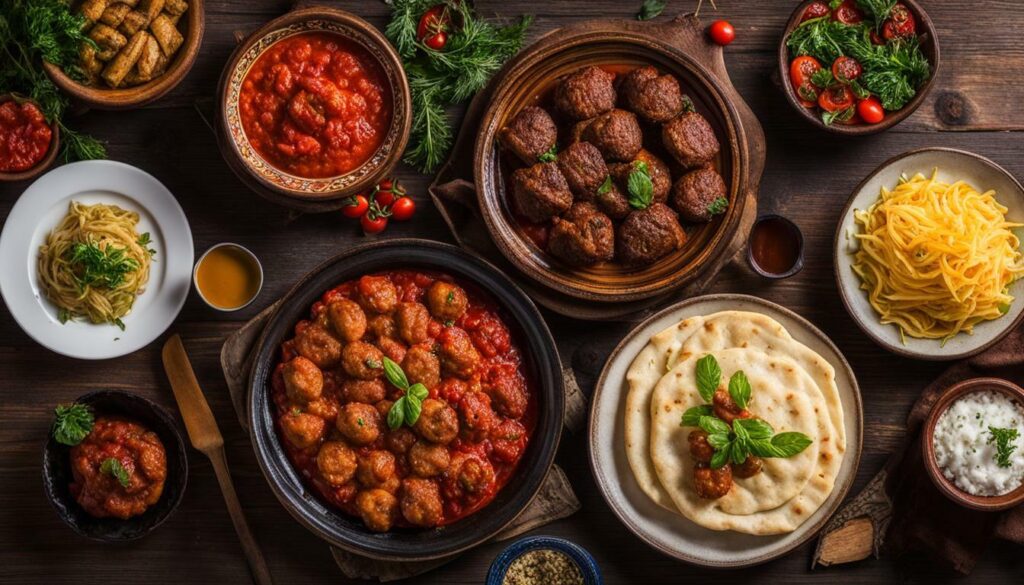
| Traditional Dish | Description |
|---|---|
| Burek | A savory pastry filled with meat, cheese, or spinach. |
| Cevapi | Grilled minced meat served with flatbread, onions, and kaymak. |
| Ajvar | A red pepper and eggplant relish, perfect as a condiment. |
| Tufahije | Poached apples stuffed with ground walnuts and topped with whipped cream. |
These traditional Bosnian dishes are just a glimpse into the country’s rich culinary heritage. Exploring the past and present diets of Bosnia and Herzegovina allows you to appreciate the varied influences and flavours that have shaped its gastronomy. Whether you’re a food enthusiast or an adventurous traveller, indulging in the local cuisine is an essential part of experiencing the vibrant culture of this beautiful country.
Cuisine in Bosnia and Herzegovina
The cuisine of Bosnia and Herzegovina is a harmonious blend of flavours, combining meat, vegetables, dairy products, and aromatic herbs and spices. The country’s rich culinary heritage reflects its diverse cultural influences, including Ottoman, Austro-Hungarian, and Mediterranean cuisines.
Traditional Bosnian dishes such as Burek, Cevapi, and Bosnian coffee are highly recommended for those looking to experience the authentic flavours of the region. Burek is a pastry filled with meat or cheese, while Cevapi are small, grilled sausages typically served with flatbread and onions. Bosnian coffee is known for its strong flavour and is traditionally prepared and served in a copper pot called a džezva.
One cannot explore the cuisine of Bosnia and Herzegovina without mentioning the influence of Turkish culture. Turkish people, Turkish flags, and Ziraat Bank branches can be found throughout the country, showcasing the historical ties between the two nations. Sarajevo, the capital city, offers a plethora of culinary delights, including the historical Ottoman market Başčaršija, where visitors can indulge in traditional Bosnian sweets and delicacies.
When it comes to exploring the natural beauty of Bosnia and Herzegovina, Mostar is a must-visit destination. Famous for its iconic Mostar Bridge, which was rebuilt after the Bosnian War, this city offers picturesque views of the Neretva River and a blend of Ottoman and Mediterranean architectural styles. Another noteworthy place to visit is Travnik, a town with a rich Ottoman heritage, where visitors can enjoy traditional Bosnian cuisine while taking in the stunning views of the surrounding mountains.
Indulge in the Flavors of Bosnia and Herzegovina
Whether you’re a food enthusiast or a traveller seeking new experiences, the cuisine of Bosnia and Herzegovina is sure to captivate your taste buds and leave you craving more. With its unique blend of cultures and a delicious array of dishes, this Balkan gem is a culinary delight waiting to be discovered.

| Dish | Description |
|---|---|
| Burek | A flaky pastry filled with meat or cheese. |
| Cevapi | Small, grilled sausages are typically served with flatbread and onions. |
| Bosnian coffee | A strong, traditional coffee brewed in a džezva. |
National Dish of Bosnia and Herzegovina
The national dish of Bosnia and Herzegovina is Cevapi, a grilled dish of minced meat served with flatbread and onions. This iconic dish is a staple in Bosnian cuisine and is loved by locals and visitors alike. The juicy and flavorful meat, typically made from a combination of beef and lamb, is seasoned with traditional Bosnian spices, giving it a unique and aromatic taste.
Cevapi is often served in portions, with each portion consisting of several small meat sausages. It is traditionally accompanied by somun, a type of Bosnian flatbread, and onions. The combination of tender meat, soft bread, and the crunch of onions creates a delightful culinary experience.

When visiting Bosnia and Herzegovina, trying Cevapi is a must. You can find this delicious dish in various restaurants and street food stalls nationwide. It’s a popular choice for locals for breakfast, lunch, or dinner and a favourite among tourists exploring Bosnian cuisine. Don’t miss the opportunity to savour Bosnia and Herzegovina’s national dish and experience this fascinating country’s rich flavours.
Festive Foods in Bosnia and Herzegovina
Festive foods in Bosnia and Herzegovina hold a special place in the hearts and palates of the people, bringing joy and togetherness during festive occasions. These traditional dishes often passed down through generations, are celebrated for their rich flavours and cultural significance. Whether it’s a wedding, religious holiday, or a family gathering, these festive foods play a central role in enhancing the overall experience.
One iconic dish that takes centre stage during celebrations is the ćevapi. These grilled minced meat sausages, typically made from a blend of beef, lamb, and sometimes pork, are served with fresh bread, onions, and a side of kajmak (a type of creamy cheese). The combination of smoky flavours, tender meat, and creamy cheese makes it a beloved choice among locals and visitors alike. It’s a dish that encapsulates the warm and convivial atmosphere of Bosnia and Herzegovina’s festive gatherings.
Another staple during celebrations is baklava, a sweet pastry made with layers of phyllo dough, finely ground walnuts or pistachios, and a sweet syrup made from honey or sugar. This indulgent treat is a symbol of hospitality and is often served alongside Bosnian coffee, a traditional drink prepared in a cezve (a small copper pot). The rich aroma and intense flavour of the coffee perfectly complement the sweetness of the baklava, creating a harmonious pairing that is appreciated by locals and visitors alike.
During festive occasions, it’s common to find a variety of traditional Bosnian dishes on the table, such as pita (a savoury pie filled with meat or cheese), sarma (stuffed cabbage rolls), and bosanski lonac (a hearty meat and vegetable stew). These dishes not only satisfy the appetite but also showcase the country’s culinary heritage and regional diversity.
| Festive Foods in Bosnia and Herzegovina | Key Features |
|---|---|
| Ćevapi | Grilled minced meat sausages served with bread and cheese |
| Baklava | Sweet pastry made with phyllo dough and nuts, served with Bosnian coffee |
| Pita | Savoury pie filled with meat or cheese |
| Sarma | Stuffed cabbage rolls |
| Bosanski Lonac | Hearty meat and vegetable stew |
These festive foods not only tantalize the taste buds but also embody the traditions, history, and cultural pride of Bosnia and Herzegovina. They are a testament to the country’s rich culinary heritage and the importance of food in bringing people together. So, next time you find yourself in Bosnia and Herzegovina during a festive celebration, make sure to savour these delightful dishes and experience the true essence of the country’s vibrant food culture.
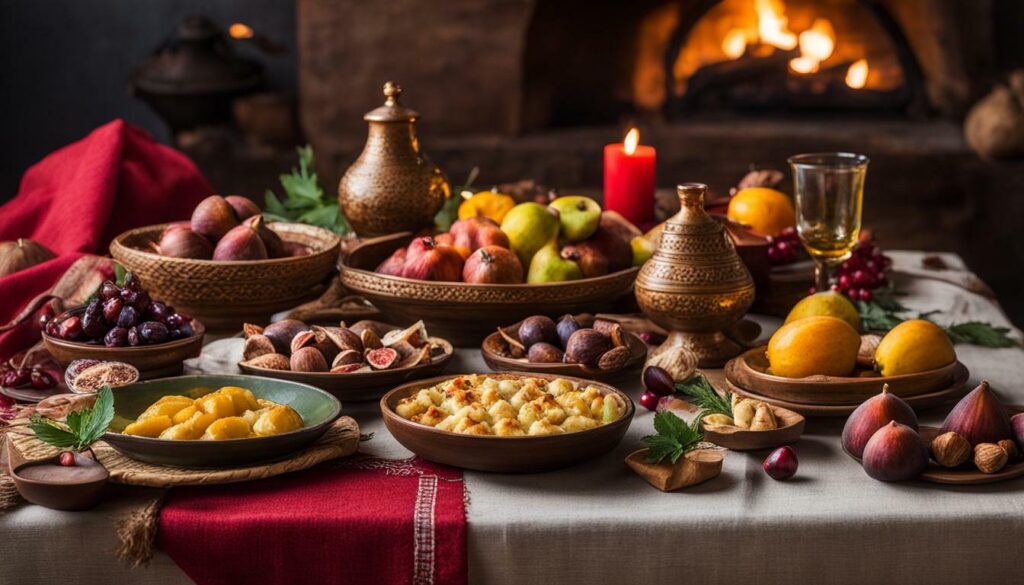
Popular Foods of Bosnia and Herzegovina
Bosnia and Herzegovina boasts a range of popular foods that have become iconic representations of its culinary heritage. These traditional dishes are cherished by locals and celebrated by visitors for their unique flavours and cultural significance. Here are some of the most famous foods in Bosnia and Herzegovina:
- Cevapi: This beloved dish consists of grilled minced meat, typically a combination of beef and lamb, served with a side of freshly baked somun bread, onions, and a dollop of kaymak, a rich and creamy dairy spread.
- Burek: A staple of Bosnian cuisine, burek is a flaky pastry filled with various fillings, such as ground beef, cheese, spinach, or potatoes. It is often enjoyed for breakfast or as a satisfying snack throughout the day.
- Bosanski Lonac: Translated as “Bosnian pot,” this hearty dish is a slow-cooked stew made with a variety of meats, vegetables, and spices. It is a symbol of Bosnian hospitality and is often prepared for special occasions or gatherings.
- Bosnian Coffee: A tradition deeply rooted in Bosnian culture, Bosnian coffee is made using a special brewing method in a long-handled pot called a “džezva.” It is served in small cups and enjoyed with a side of Turkish delight or other sweet treats.
These popular foods reflect the diverse culinary influences of the region, including Ottoman, Turkish, and Balkan flavours. They showcase the rich history and cultural heritage of Bosnia and Herzegovina, making them a must-try for any food enthusiast visiting the country.
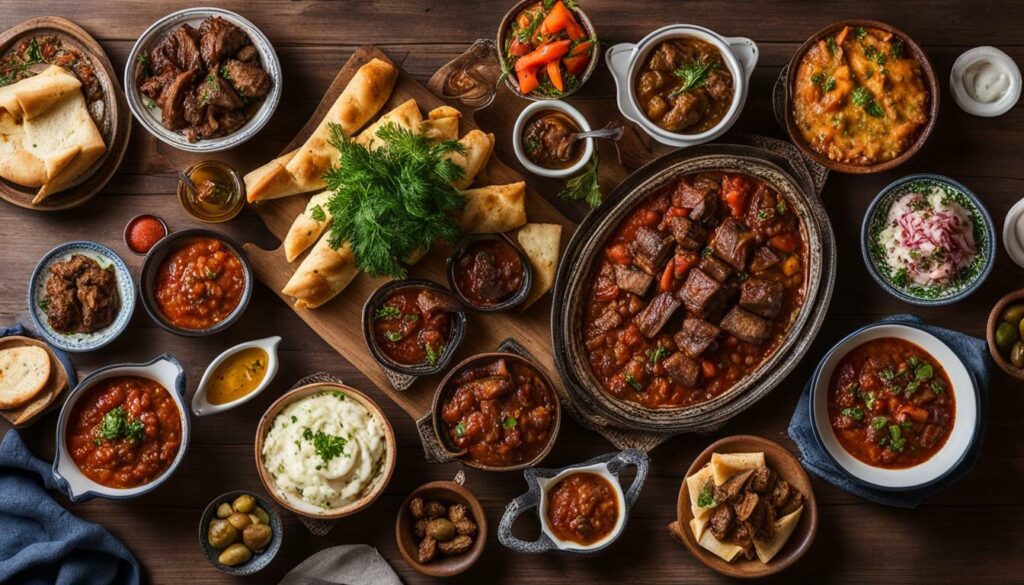
The image above showcases the mouth-watering beauty of Bosnian cuisine, enticing the senses with its vibrant colours and tantalizing aromas.
Traditional Bosnian Recipe: Cevapi
“Cevapi is a cherished Bosnian dish that brings people together through its delicious simplicity. The combination of grilled meat, soft bread, and creamy kaymak creates a harmonious balance of flavors that is truly unforgettable. It is a dish that represents the warmth and generosity of Bosnian hospitality.”
To prepare this traditional Bosnian recipe, follow these simple steps:
| Ingredients: | Instructions: |
|---|---|
|
|
Indulge in the culinary delights of Bosnia and Herzegovina, and experience a taste of its vibrant food culture. From the famous cevapi to the comforting Bosnian pot, each dish tells a story of tradition, history, and the warm hospitality of the Bosnian people.
Bosnia and Herzegovina’s Culinary Journey
The culinary journey of Bosnia and Herzegovina reflects a fusion of historical influences and contemporary gastronomic trends. Traditional Bosnian dishes, such as Burek, Cevapi, and Bosnian coffee, showcase the country’s rich cultural heritage. These dishes are a testament to the Ottoman and Turkish influence on Bosnia and Herzegovina’s food culture.
“Bosnian cuisine offers a harmonious blend of flavors and textures, with an emphasis on locally sourced ingredients and traditional cooking techniques,” says Chef Emir Halilović, a prominent Bosnian chef.
Bosnian cuisine is characterized by hearty and filling meals, often centred around meat, bread, and dairy products. The use of spices, such as paprika, cumin, and coriander, adds depth and complexity to the dishes. Traditional Bosnian desserts, such as Tufahije (stuffed apples) and Baklava, are a sweet and indulgent end to a meal.
When visiting Bosnia and Herzegovina, exploring the local cuisine is a must. The vibrant markets, such as the historical Ottoman market Başčaršija in Sarajevo, offer a feast for the senses. Here, you can witness the hustle and bustle of locals shopping for fresh produce, spices, and traditional delicacies.
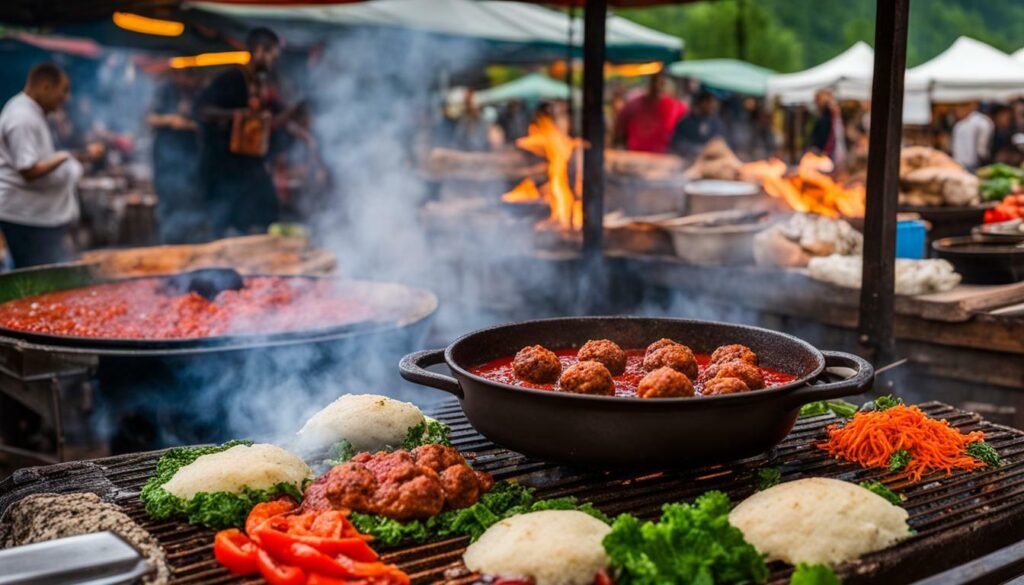
Must-Try Dishes
- Burek: A flaky pastry filled with meat, cheese, or spinach.
- Cevapi: Grilled minced meat sausages served with flatbread and onions.
- Bosnian coffee: A strong and aromatic coffee preparation served in a traditional copper pot.
Whether you’re strolling through the narrow streets of Sarajevo or enjoying the stunning landscapes of Mostar, Bosnia and Herzegovina’s culinary scene is sure to captivate your taste buds. From rich stews to savoury pies and sweet treats, the country offers a culinary experience that is as diverse as its cultural heritage. So take a bite of Bosnia and Herzegovina’s flavorful cuisine and embark on a gastronomic adventure like no other.
| Challenges in Nutrition Policies | Progress in Nutrition Policies |
|---|---|
| Reduction of salt/sodium consumption | Reduction of childhood stunting |
| Limitation of saturated fatty acid intake | Increased exclusive breastfeeding |
| No sugar-sweetened beverage tax | N/A |
| No policy to eliminate industrially produced trans fatty acids | N/A |
| N/A | Reduction of anaemia among women |
| N/A | Reduction of adolescent and adult overweight |
Challenges and Progress in Nutrition Policies
Bosnia and Herzegovina has implemented various nutrition policies to address specific dietary concerns and promote healthier lifestyles. The country has made significant progress in reducing childhood stunting and increasing exclusive breastfeeding, which is crucial for the optimal growth and development of children. However, there are still challenges that need to be addressed to improve the overall nutrition status of the population.
One area of concern is the high prevalence of anaemia among women in Bosnia and Herzegovina. Anaemia can have serious consequences for both the mother and child, including increased risk of complications during pregnancy and childbirth. Efforts should be made to raise awareness about the importance of iron-rich foods and the need for regular screening and treatment of anaemia in women of reproductive age.
Another challenge is the high prevalence of overweight and obesity among adolescents and adults in the country. Excess weight can increase the risk of various chronic diseases, including cardiovascular disease and type 2 diabetes. It is essential to implement strategies that promote healthy eating habits and physical activity to prevent and reduce overweight and obesity in the population.
Bosnia and Herzegovina has made significant progress in implementing policies to reduce salt/sodium consumption and limit saturated fatty acid intake. These policy measures are important for reducing the risk of hypertension and cardiovascular disease. However, there is still room for improvement, as the country does not currently have a sugar-sweetened beverage tax or a policy to eliminate industrially produced trans fatty acids, both of which have been shown to be detrimental to health.
| Key Challenges and Progress in Nutrition Policies | Current Status |
|---|---|
| Childhood Stunting | Significant progress has been made in reducing childhood stunting through various interventions and programs. |
| Exclusive Breastfeeding | Efforts have been made to increase exclusive breastfeeding rates, but more work is needed to ensure widespread adoption. |
| Anaemia Among Women | High prevalence of anaemia among women calls for targeted interventions to improve iron status and awareness. |
| Adolescent and Adult Overweight | Prevalence of overweight and obesity remains a challenge, highlighting the need for effective strategies to promote healthy weight management. |
| Salt/Sodium Consumption | Policy measures have been implemented to reduce salt/sodium consumption and promote healthier dietary choices. |
| Saturated Fatty Acid Intake | Efforts have been made to limit saturated fatty acid intake, recognizing its association with cardiovascular disease. |
| Sugar-Sweetened Beverage Tax | No current policy on sugar-sweetened beverage tax, highlighting an area for potential improvement in future nutrition policies. |
| Industrially Produced Trans Fatty Acids | No current policy to eliminate trans fatty acids, indicating an opportunity for further action in improving food quality. |
“Addressing the nutrition challenges in Bosnia and Herzegovina requires a multi-faceted approach that includes implementing evidence-based policies, promoting education and awareness, and fostering collaboration between the government, healthcare professionals, and the food industry. By working together, we can create a healthier future for the population.”
It is important to continue monitoring the progress of nutrition policies in Bosnia and Herzegovina and make necessary adjustments to ensure their effectiveness. By addressing the existing challenges and focusing on areas for improvement, the country can further enhance the well-being and nutritional status of its population.
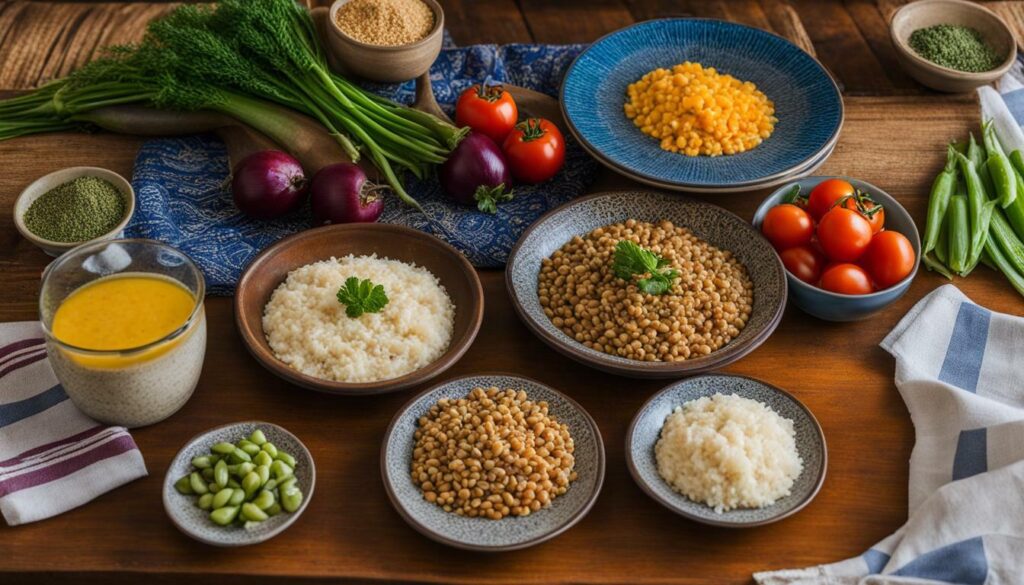
Improvements and Areas for Development
While progress has been made, there are still areas of improvement in Bosnia and Herzegovina’s nutrition landscape, particularly concerning childhood stunting, breastfeeding rates, anaemia, and overweight.
In terms of childhood stunting, efforts have been made to reduce its prevalence through various programs and interventions. These initiatives focus on improving access to nutritious food, enhancing breastfeeding practices, and promoting proper child growth and development. Despite these efforts, childhood stunting remains a concern, and further action is needed to address the underlying causes and ensure the well-being of the younger generation.
A similar focus is required on exclusive breastfeeding rates, as it plays a crucial role in providing infants with essential nutrients and a healthy start in life. Although there have been improvements in exclusive breastfeeding rates in Bosnia and Herzegovina, there is still work to be done to encourage and support mothers in their breastfeeding journey.
Another area for development is reducing the prevalence of anaemia among women. Anaemia can have detrimental effects on the health and well-being of women, impacting their daily lives and overall productivity. Increased awareness, education, and access to iron-rich foods and supplements can help combat this issue and improve the nutritional status of women in the country.
Finally, addressing the issue of adolescent and adult overweight is crucial for promoting overall health and reducing the burden of non-communicable diseases. Implementing policies that promote healthy eating habits, regular physical activity, and a supportive environment can contribute to combating overweight and obesity in Bosnia and Herzegovina.
| Data | Statistic |
|---|---|
| Childhood Stunting | Prevalence of childhood stunting: 17.4% |
| Exclusive Breastfeeding | Exclusive breastfeeding rate at 6 months: 32.8% |
| Anaemia among Women | Prevalence of anaemia among women of reproductive age: 21.7% |
| Adolescent and Adult Overweight | Prevalence of overweight among adolescents: 25.4% Prevalence of overweight among adults: 52.9% |
Addressing these areas of improvement will require a multi-faceted approach, involving collaboration between government agencies, healthcare providers, educators, and the community. By prioritizing nutrition and implementing evidence-based interventions, Bosnia and Herzegovina can continue to make strides towards a healthier population.
Culinary Tourism in Bosnia and Herzegovina
Culinary tourism in Bosnia and Herzegovina offers a delightful journey for food enthusiasts, showcasing the country’s rich culinary traditions and diverse flavours. From traditional Bosnian dishes to unique regional specialities, there is something to tantalise every taste bud. Exploring the local cuisine allows visitors to delve into the heart of Bosnian culture and experience the country’s vibrant food scene.
One cannot talk about Bosnian cuisine without mentioning some of the iconic traditional dishes. Burek, a flaky pastry filled with meat or cheese, is a must-try for its delicious combination of flavours. Cevapi, tender grilled sausages served with flatbread and onions, is another beloved dish that embodies Balkan cuisine. And let’s not forget about Bosnian coffee, a strong and aromatic beverage that is an integral part of Bosnian culture and hospitality.
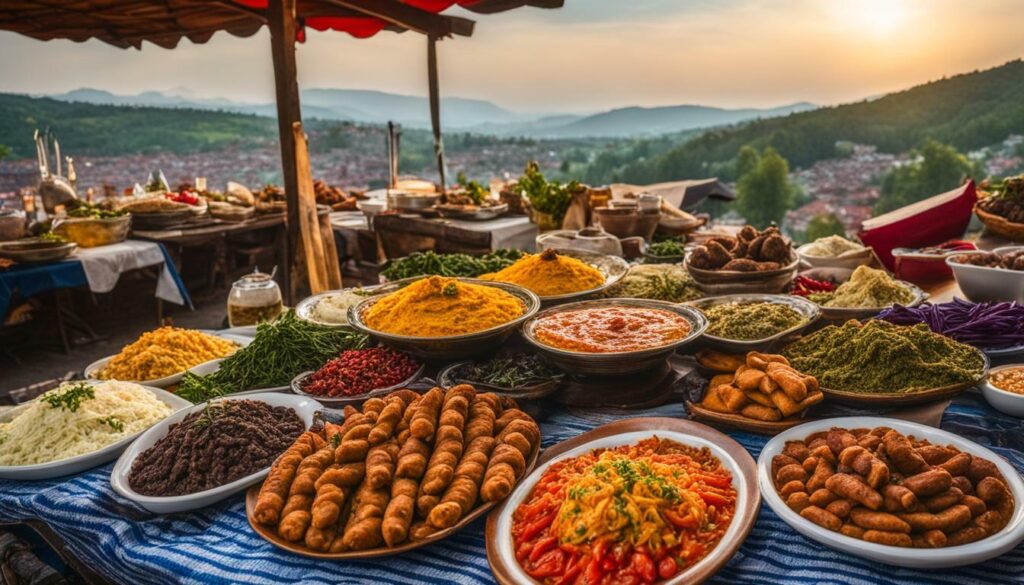
When it comes to exploring culinary destinations, Sarajevo is a must-visit city. It offers a mix of Ottoman, Austro-Hungarian, and Yugoslav influences, resulting in a diverse range of flavours and culinary experiences. Wander through the historical Ottoman market Başčaršija, where you can sample traditional sweets like baklava or try local delicacies such as dolma (stuffed vegetables) and ćevapčići.
Another notable city for culinary exploration is Mostar, famous for its iconic Mostar Bridge and its role in the Bosnian War. Here, you can savour traditional dishes like mantije (meat-filled dumplings) while enjoying the breathtaking views of the Neretva River. Travnik, with its rich Ottoman heritage, is another gem to discover, offering dishes like begova čorba (a hearty meat stew) and traditional Bosnian pies.
With its unique blend of cultures and delicious cuisine, Bosnia and Herzegovina provides a memorable culinary experience for visitors. From exploring traditional dishes to discovering hidden gems in local markets and cafes, culinary tourism in this Balkan country is a feast for the senses.
Recommended Traditional Dishes:
- Burek – A flaky pastry filled with meat or cheese
- Cevapi – Grilled sausages served with flatbread and onions
- Bosnian coffee – A strong and aromatic beverage
- Mantije – Meat-filled dumplings
- Dolma – Stuffed vegetables
- Begova čorba – A hearty meat stew
Must-Visit Culinary Destinations:
- Sarajevo – Explore the historical Ottoman market Başčaršija
- Mostar – Enjoy traditional dishes while admiring the Mostar Bridge
- Travnik – Discover the rich Ottoman heritage and indulge in Bosnian pies
Don’t Miss:
“The Bosnian cuisine is a reflection of our history, diversity, and hospitality. Exploring our culinary traditions is not just a journey for the taste buds, but a way to connect with our culture and heritage.” – Local Food Enthusiast
| Traditional Dish | Location | Description |
|---|---|---|
| Burek | Throughout the country | A flaky pastry filled with meat or cheese |
| Cevapi | Throughout the country | Tender grilled sausages served with flatbread and onions |
| Bosnian coffee | Throughout the country | A strong and aromatic beverage |
| Mantije | Mostar | Meat-filled dumplings |
| Dolma | Sarajevo | Stuffed vegetables |
| Begova čorba | Travnik | A hearty meat stew |
Conclusion
The past and present diets of Bosnia and Herzegovina reflect a vibrant culinary heritage that should be celebrated and experienced through its traditional recipes. Exploring the rich food culture of this country reveals a diverse range of dishes that have been influenced by various cultural factors over time. From traditional Bosnian delicacies like Burek, Cevapi, and Bosnian coffee to the fusion of Turkish and Ottoman flavours, there is something to satisfy every palate.
While Bosnia and Herzegovina have made progress in their nutrition policies, there are still challenges to overcome. The country has taken steps to reduce salt and saturated fatty acid intake, but there is room for improvement in addressing sugar-sweetened beverages and trans fatty acids. On a positive note, efforts to reduce childhood stunting and increase exclusive breastfeeding have yielded positive results, but there is a need to tackle anaemia among women and reduce overweight in adolescents and adults.
When visiting Bosnia and Herzegovina, exploring the country’s culinary delights is a must. The capital city of Sarajevo offers a mix of history and gastronomy, with attractions like the Ottoman market Başçarşı, the Kovači War Cemetery, and the Tunnel of Hope. Another gem is the city of Mostar, famous for its iconic Mostar Bridge and the role it played during the Bosnian War. Travnik, with its rich Ottoman heritage, is also worth a visit.
In conclusion, Bosnia and Herzegovina’s past and present diets are a reflection of its cultural diversity and historical influences. The country’s traditional recipes and culinary offerings are a testament to its vibrant heritage. By celebrating and experiencing these authentic dishes, visitors can truly appreciate the unique blend of cultures and flavours that make Bosnia and Herzegovina a culinary destination like no other.
FAQ
What are the challenges and progress in nutrition policies in Bosnia and Herzegovina?
The challenges and progress in nutrition policies in Bosnia and Herzegovina include the implementation of policies to reduce salt/sodium consumption and limit saturated fatty acid intake. However, there is no sugar-sweetened beverage tax and no policy to eliminate industrially produced trans fatty acids.
What improvements have been made in nutrition in Bosnia and Herzegovina?
Bosnia and Herzegovina has made progress in reducing childhood stunting and increasing exclusive breastfeeding.
What areas require development in nutrition in Bosnia and Herzegovina?
Areas that still require development in nutrition in Bosnia and Herzegovina include reducing anaemia among women and reducing adolescent and adult overweight.
What are some traditional Bosnian dishes recommended to try?
Some traditional Bosnian dishes recommended to try are Burek, Cevapi, and Bosnian coffee.
What are some popular attractions in Bosnia and Herzegovina?
Some popular attractions in Bosnia and Herzegovina include the historical Ottoman market Başçarşı, the Kovači War Cemetery, the Tunnel of Hope, and the famous Mostar Bridge in Mostar.
What is the national dish of Bosnia and Herzegovina?
The national dish of Bosnia and Herzegovina is (insert national dish).
What are some festive foods in Bosnia and Herzegovina?
Some festive foods in Bosnia and Herzegovina include (insert festive foods).
What is the culinary journey of Bosnia and Herzegovina?
The culinary journey of Bosnia and Herzegovina encompasses traditional recipes and modern food preferences, showcasing the evolution of the country’s food culture.
How is culinary tourism in Bosnia and Herzegovina growing?
Culinary tourism in Bosnia and Herzegovina is on the rise, with visitors drawn to the country’s unique food experiences and attractions.
What is the importance of exploring the past and present diets of Bosnia and Herzegovina?
Exploring the past and present diets of Bosnia and Herzegovina allows for a deeper understanding of the country’s cultural heritage and culinary traditions.
Source Links
- https://globalnutritionreport.org/resources/nutrition-profiles/europe/southern-europe/bosnia-and-herzegovina/
- https://blog.turkishairlines.com/en/exploring-history-and-cuisine-bosnia-herzegovina/
- https://www.ncbi.nlm.nih.gov/pmc/articles/PMC6747026/



